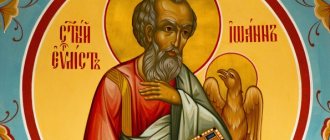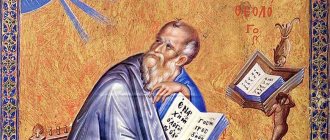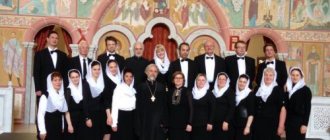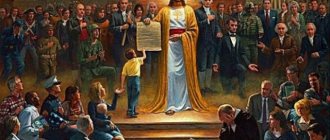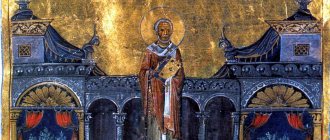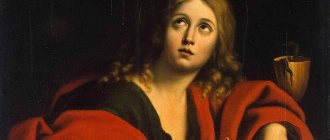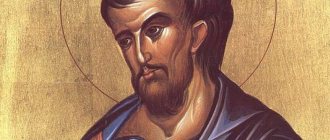When they talk about bowing, they remember reverence and humility. The sign of the cross and bow are the most important ritual actions in Christianity. The Charter strictly regulates the types of bows - believers need to understand such details. There are ground and waist varieties of bow - both of them are associated with bodily prayers. In some cases, you can pray in a temple without bowing. God allows such things, but it’s better to ask the priest again (if in doubt).
There are general rules for any Orthodox services. Thus, bows from the waist are prescribed for believers to shout “Hallelujah” three times in some prayers. Sometimes the homage has to be deep, sometimes not. According to the rules, you need to bow when:
- prayers;
- Litany;
- Akathist;
- overshadowed by the Cross;
- end of service.
When is it appropriate to be baptized without bowing?
A special atmosphere reigns in temples - every thing occupies a designated place, every action is endowed with a sacred meaning. A church charter has been developed that teaches worshipers to do everything correctly. Every icon is installed in a designated place; Orthodox traditions with a thousand-year history are everywhere. Here are some points to consider:
- There are different types of bows.
- In temples you need to bow often, but with skill.
- Sometimes there is no need to bow at all.
- The types of bows depend on the time of their use.
At the very beginning of the “I Believe” prayer, kneeling and bowing are not required. When reading the sixth psalm (the very middle), do not bow when shouting “Hallelujah”. When the words of the proverbs, the apostle and the Gospel are pronounced under the arches of the temple, one should limit oneself to the imposition of a cross. On some holidays, bows should also be neglected.
Varieties of bows
St. John of Kronstadt called bowing the head a tool that helps to eradicate the pride that is lodged deep in the soul. The Typicon prescribes two types of veneration:
- Small, or waist. This involves bending the body at the waist while lowering the head. As a rule, it is customary to place them during home or congregational prayers.
- Great, or earthly. They represent kneeling, placing your forehead on the floor. For example, during fasting they are placed three times while reading a prayer of repentance.
When to be baptized with a bow
Thanks to the church charter, small and large bows invariably accompany all services. There is no need to freeze or rush; try to act synchronously with other parishioners while reading or singing. When praying, you must first cross yourself and then bow. The idea of a waist bow is to bring your head down to waist level (hence the name). The church charter specifies the following situations for bowing from the waist:
- When visiting a temple (three times at the entrance and the same number of times at the exit).
- When the clergyman praises the Trinity.
- Petition for litanies.
- With prayer words beginning with the exclamation “Pureest.”
- When the priest mentions bows and adorations.
There are words in the temple that trigger the process of threefold veneration. These include exclamations of “Hallelujah,” “Come, Let Us Worship,” and “Holy God.” The choir, which concludes the singing of the stichera, is also forced to bow to the waist and at the same time cross itself. Three bows must be measured in litanies, after the first three petitions. Further in the litanies the number of bows is reduced to one.
In addition to these bows, there are also the following:
When shouting “Peace to all” or “Grace of our Lord Jesus Christ...”, when the priest blesses the people, bow your head, without the sign of the cross;
- when leaving without the Cross - bow your head, without the sign of the cross;
- when reading the Gospel - stand with your head bowed;
- when censing - respond to the censer with a bow, without the sign of the cross;
- when shouting “Bow your heads to the Lord,” bow your head;
- when leaving with the Cross - bow with the sign of the cross;
- when overshadowing those praying with the Cross, Gospel, icon or Chalice - bow with the sign of the cross;
- when overshadowing those praying with candles or with a hand - a bow without the sign of the cross.
Note:
The rules about prostrations do not apply to Sundays. Read more: On the inadmissibility of prostrations on Sundays.
The text is based on the publication: Patriarchal Orthodox Calendar. Instructions of the Holy Fathers on prayer. 2008. Author-compiler E.Yu. Head Publishing Council of the Russian Orthodox Church, 2007. February 5–9.
When is it appropriate to be baptized with a bow to the ground?
Bows to the ground can be three or one, and their number depends on the degree of solemnity of the moment. When it comes to a great bow, everyone remembers earnestness, decorum and leisureliness. Before visiting the temple, you can practice in front of a mirror - you will certainly succeed. Try to avoid moments when bowing overlaps with singing or reading prayers - this is wrong. It is prohibited to make the sign of the cross while bowing; these actions must be distinguished. Let us list the phrases and words in which (after or during) prostrations are considered obligatory:
- “We’ll sing to you”;
- “We magnify you”;
- “And make us worthy”;
- "Worthy."
Let us immediately note that the earthly analogue of a bow involves lowering the believers to their knees and touching their foreheads to the surface of the floor.
Particular attention should be paid to the appearance of the Holy Gifts and Lent. At this time, threefold prostrations are accompanied by a series of twelve small bows. Such actions begin on Friday and Wednesday, they are timed to coincide with Cheese Week. On Sundays and Saturdays, fasting bows are not made. There are moments when absolutely all prayer verses (“To the Most Holy Lady”) are accompanied by bows. The Lenten Supper involves three bows during the recitation of the key prayer, and it is also necessary to bow to the ground when reading “Lord and Master.” Remember that glorifying Jesus Christ is a responsible matter. It is better to once again consult with knowledgeable people than to perform rituals incorrectly.
What are bows
Bowing in church is the bowing of the body before God during prayer. They are usually performed after making the sign of the cross . During worship, a person bows many times.
Bows happen:
- Belt . A person bends at the waist while bowing from the waist, without bending his knees, touching the floor with his hand. Then he straightens his back. Otherwise called “small”.
- Terrestrial . They are also called “great”. When bowing to the ground, a person falls to his knees, touching his forehead to the floor. Then he gets up and straightens up.
There are different times for making prostrations and bows. On Sundays and church holidays, only bows from the waist are performed; high bows are prohibited. And during Great Lent, the most prostrations are performed, especially during the reading of the prayer of St. Ephraim the Syrian. During the period from Easter to Pentecost one cannot make great bows.
While reading the Six Psalms, it is forbidden to make even small bows; you can only cross yourself. When blessing the priest, you just need to bow your head, but not bow. When blessing with a cross, you must make the sign of the cross and make a small bow.
Bowing to the ground without the sign of the cross
Prostrations to the ground are also not always combined with the sign of the cross. Church regulations do not provide for bowing when a person has received communion in the morning. This restriction is valid until evening hours. It is worth considering that in the Orthodox Church the liturgical day is counted from the evening service. Accordingly, the communion dates back to yesterday, and bowing is again encouraged.
In general, in order not to make mistakes with prostrations, we recommend carefully observing the priest. On Sundays and great holidays, bowing low is considered an unacceptable action. There are also time periods with restrictions on kneeling:
- between Christmas and Epiphany;
- Elevation;
- Transfiguration;
- Easter and Pentecost.
Worship, as you know, is divided into regulated parts. Some stages also do not include prostrations. These are the Six Psalms, the Cherubim, the Great Doxology and the Most Honest. In the process of singing and litanies, one also cannot be baptized, but by bowing to please the Almighty is quite acceptable. Wait until the chants are completed - after that completely different laws will begin to apply.
In general, the Orthodox traditions of kneeling do not encourage. Prolonged kneeling is a Catholic tradition. The Slavs limit themselves to bowing to the ground and do not stay in this position for too long. Low bows without making the sign of the cross are also practiced in other situations:
- Liturgy of the Presanctified Gifts;
- Day of the Holy Trinity;
- removal of miraculous icons;
- removal of the relics of saints.
Church of the Holy Apostle and Evangelist John the Theologian on Bronnaya
The church service is performed with many great and small bows. The Holy Church requires bowing with inner reverence and outer decorum, without haste and “without becoming rigid” (that is, without freezing, for example, with a hand raised to the forehead), at the same time as all those praying in the church. Before bowing, you need to sign yourself with the sign of the cross, and then bow. With a small bow, one bends down so that the head is at waist level (waist bow), with a great bow, one must bend both knees and reach the ground with the head (prostration).
Prostrations in church should be performed when it is indicated by the Church Charter, and not out of one’s sinful self-will. “If, standing in church, you bow when the Church Charter commands it, then you try to restrain yourself from bowing when the charter does not require it, so as not to attract the attention of those praying, or you hold back sighs that are ready to burst from your heart, or tears ready to pour out from your eyes - in such a disposition, and among the numerous congregation, you secretly stand before Your Heavenly Father, Who is in secret, fulfilling the commandment of the Savior (Matthew 6, 6).” (St. Philaret, Metropolitan of Moscow).
It is necessary to be baptized without bowing:
1. At the beginning of singing or reading “I Believe...”, “The King of Heaven...”, “The Only Begotten Son and Word of God...”.
2. On dismissal “Christ our true God...”.
3. At the beginning of reading the Holy Scriptures: the Apostle and proverbs.
Cross yourself with a bow:
1. When entering the temple and when leaving it (three bows).
2. When shouting: “Take, eat...”, “Drink from it all...”, “Thine from Thine...”.
3. After singing “Our Father” at the liturgy on holidays and Sundays.
4. When shouting “Holy to Holies” on holidays and Sundays.
5. After singing “Most honorable Cherub...”.
6. During the reading of the Trisagion, reading or singing three times “Hallelujah”, “Come, let us bow...”, after the exclamation “Glory to Thee, Christ God...”, before dismissal (three bows).
7. At the litia (after each of the first two petitions of the litanies - three bows, after the other two - one each). When reading the prayer “Master is Most Merciful...” we sign ourselves with the sign of the cross and bow our heads.
8. At the beginning of the reading or singing “Voucher, Lord...” at Vespers and the Great Doxology at Matins (three bows).
9. When reading the canon, on the 1st and 9th cantos, during the first prayerful address (chorus) to the Savior, the Mother of God, and the saints.
10. When singing “Be the name of the Lord...” at the end of Vespers and Liturgy (three bows).
11. With all the exclamations of “Let us bow our heads to the Lord,” we make the sign of the cross and bow our heads until the exclamation of the priest.
12. After singing “Glory to Thee, our God, glory to Thee,” before and after reading the Gospel, and after shouting “Let us take notice,” we make the sign of the cross and bow our heads.
13. At the Liturgy, at the beginning of the singing of the Cherubim, we make the sign of the cross and bow our heads until the Holy Gifts are taken out. After the words of the priest “May the Lord God remember you all...” three bows.
Be baptized with a bow to the ground:
1. On days of fasting, when entering the temple and when leaving it (three bows).
2. On days of fasting, at Matins, after each chorus to the song to the Mother of God “My soul magnifies the Lord...”, after the words “We magnify Thee...”.
3. At the end of singing “We will sing to you...”.
4. After “It is worthy to eat” or worthy.
5. After singing the “Our Father” at the liturgy on weekdays.
6. When shouting “Holy of Holies” on weekdays.
7. When carrying out the Holy Gifts, with the words “With the fear of God...”, and a second time - with the words “Always, now and ever and unto ages of ages.”
8. During Lent, at the Liturgy of the Presanctified Gifts, during the exclamation “The Light of Christ enlightens everyone.”
9. During Great Lent, at the Liturgy of the Presanctified Gifts, while singing “May my prayer be corrected...” and “Now the Heavenly Powers...” one bows to the ground.
10. In Great Lent, at Great Compline, while singing “To the Most Holy Lady...” (bow on each verse); while singing “Virgin Mother of God, rejoice...” and so on at Lenten Vespers (three bows).
11. During Lent, while reading the prayer of St. Ephraim the Syrian.
12. In Lent, during the final singing of “Remember us, Lord, when you come in Your Kingdom” (three prostrations to the ground).
13. At Great Vespers on the Feast of the Holy Trinity, at the deacon’s exclamation “Paki and paki, bend the knee...”, they kneel and bow their heads to the ground until the end of the prayers.
Half bow without the sign of the cross:
1. At the words of the priest “Peace to all”, “The blessing of the Lord be upon you...”, “The grace of our Lord Jesus Christ...”, “And may the mercies of the Great God be...”.
2. At the end of the dismissal, if the priest pronounces it without a cross.
Prostration without the sign of the cross:
1. During Great Lent, at the end of Great Compline, during the prayer “Master of Much Mercifulness...” one bows to the ground until the end of the prayer.
2. During Great Lent, at the end of Great Compline, after the words of the priest “Forgive me, most honorable fathers and brethren...”.
It is not necessary to be baptized:
1. While reading the Six Psalms.
2. While reading or singing psalms and stichera. On the stichera and psalms, bows are relied upon only when the words themselves call for it: “let us bow,” “we bow down,” “we bow down,” “let us fall down,” “we fall down,” etc.
Prostrations to the ground are not allowed:
On Sundays, on the twelve feasts, on the days from the Nativity of Christ to Epiphany, from Easter to Pentecost. Bowing stops from the evening entrance (during the singing of “Quiet Light”) on the eve of the holiday until the singing of “Grant, O Lord...” at Vespers on the very day of the holiday.
When according to the charter it is not necessary to bow
When is there no need to bow? A fairly common situation is when parishioners actively cross themselves, but do not bow. Above we mentioned the Six Psalms - this event is usually tied to all-night vigils. The reader recites six psalms, and there is no place for bowing. The ceremony is carried out in complete silence and symbolizes the expectation of the Savior.
There is no room for bowing even if the clergyman sings the Creed. Saying aloud texts from the Gospel and the Apostle also excludes bowing. Returning to the all-night vigil, it is worth remembering the proverbs. As you can see, church charters regulate any actions of parishioners, including kneeling, prayers and signs of the cross. If you intend to become an active member of the Orthodox community, it is worthwhile to carefully study the rules described above.
